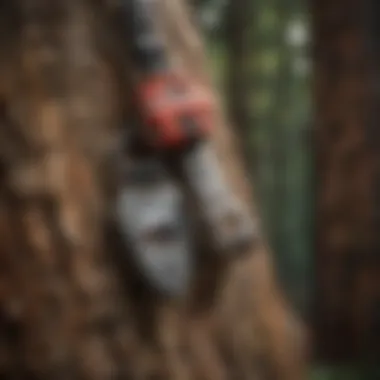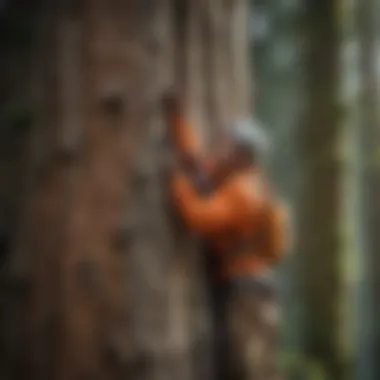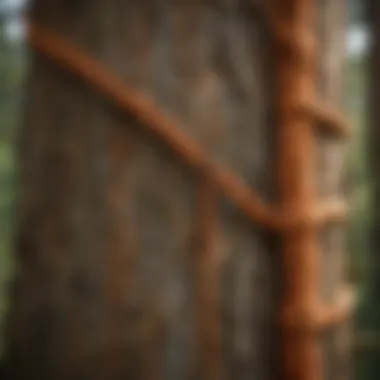Essential Tree Cutting Climbing Gear Guide


Intro
Tree cutting is an essential aspect of forestry practices, requiring not just skill, but also appropriate equipment. The right climbing gear enhances both safety and efficiency for those working among the branches. This guide aims to provide comprehensive insights on the essential gear needed, allowing both professionals and enthusiasts to approach tree cutting with greater confidence and knowledge.
Understanding Forestry Practices
Forestry practices encompass a variety of methods and approaches aimed at sustainable management of forest resources. Recognizing the different types helps to contextualize the importance of climbing gear in tree cutting operations.
Types of Forestry Practices
Several primary types of forestry practices exist, including:
- Silviculture: The practice of managing forest growth and regeneration for timber production.
- Reforestation: The replanting of trees in areas where forest cover has been disturbed or removed.
- Agroforestry: Integrating trees and shrubs into agricultural systems for enhanced biodiversity and productivity.
- Wildfire Management: Implementing techniques to prevent and control wildfires, preserving forest health.
Understanding these practices provides insight into how climbing gear plays a role in ensuring safety and efficiency during tree cutting tasks.
Historical Context
Historically, tree cutting relied on basic tools and manual skills. Over the years, as the understanding of forest ecology expanded, so too did the approach to tree management. Early forestry practices often overlooked safety measures, resulting in accidents and long-term environmental impacts. The evolution of equipment and safety protocols has improved drastically, emphasizing the need for specialized climbing gear.
"The advancement in climbing gear reflects both technological progress and growing awareness of safety in forestry practices."
Principles of Woodland Stewardship
Woodland stewardship involves responsible management of forest resources, ensuring their sustainability and health. The principles guiding this stewardship are critical for understanding why specific climbing gear is necessary.
Conservation Techniques
Conservation techniques include methods such as selective logging, maintaining biodiversity, and protecting water resources. Each technique influences the tools climbers need. Proper gear allows workers to navigate the treetops with minimum disruption to the surrounding ecosystem.
Managing Forest Resources
Efficient management of forest resources aligns with responsible climbing practices. This may include using advanced gear that prevents excessive cutting, such as selecting which branches to remove without damaging the tree. Understanding resource management helps climbers choose the right equipment that complements their methodology.
Sustainable Forest Management
Sustainable forest management combines ecological, social, and economic aspects to create a comprehensive approach to forestry. Prioritizing sustainability not only benefits the environment but also enhances the competencies of the climbers involved.
Certification Standards
Various certification standards exist to guide sustainable practices in forestry. These include organizations like the Forest Stewardship Council (FSC) and the Programme for the Endorsement of Forest Certification (PEFC). Familiarity with these standards informs climbers about best practices and the gear that aligns with sustainability goals.
Economic Benefits of Sustainability
Sustainable practices often lead to economic benefits, such as increased timber quality and market value. Efficient use of climbing gear maximizes productivity while minimizing environmental impact. This dual focus on economic gain and ecological preservation is essential for modern forestry practices.
Intro to Tree Cutting Climbing Gear
Tree cutting is a demanding activity that requires not just skill but also the right set of gear. The role of climbing gear in this process cannot be overstated. Proper equipment ensures not just efficiency but, more crucially, safety for those involved in the task. Without the right tools, the risks associated with tree cutting, including falls and injuries, significantly increase. Therefore, recognizing the importance of quality gear is essential for anyone looking to engage in tree cutting, whether they are professionals or enthusiasts.
Importance of Proper Gear
Selecting suitable climbing gear is paramount. Proper gear can mean the difference between a smooth operation and a hazardous situation. Harnesses designed for optimal support, ropes with the appropriate strength, and footwear that provides traction contribute directly to performance and safety. Let's consider some of the critical advantages that come with investing in high-quality climbing gear:
- Safety: This is the most significant concern. Quality equipment like helmets and gloves protects against unexpected accidents.
- Efficiency: Well-designed gear can enhance your capability to maneuver through trees, allowing you to work faster and more effectively.
- Comfort: With the right equipment, climbers can focus on their tasks without the distraction of poor fit or discomfort.
In summary, the implications of using the right climbing gear extend beyond mere convenience. They encapsulate the very essence of tree cutting as a safe and responsible practice.
Scope of the Article
This article aims to provide a comprehensive overview of tree cutting climbing gear. It will cover various types of essential equipment necessary for this demanding task, highlighting their distinctive features and uses. The subsequent sections will explore:
- A detailed examination of harnesses, climbing ropes, carabiners, specialized footwear, and protective gear.
- Best practices for using and maintaining this gear, ensuring longevity and reliability.
- Considerations for selecting the right equipment based on individual needs, skill levels, and environmental factors.
Through this exploration, readers will gain insights into the critical aspects of tree cutting gear, better equipping them for safe and effective operations. This knowledge will not only boost their confidence while climbing but can also enhance overall productivity.


Types of Climbing Gear
Tree cutting requires specialized climbing gear to ensure safety and efficiency. Selecting the right equipment significantly affects the performance of forestry tasks. This section discusses different types of climbing gear and the unique attributes of each category that contribute to effective tree cutting.
Harnesses
Definition and Purpose
A harness is a specially designed piece of equipment that secures the user to a rope system. Harnesses play a crucial role in providing support and safety while climbing. The key characteristic of harnesses is their ability to distribute the fall force evenly across the body, reducing the risk of injury. This is a beneficial choice for tree cutting because it allows the user to work confidently at height.
Unique features include adjustable leg loops and quick-release buckles, which enhance comfort and efficiency. However, improper fitting can lead to discomfort, necessitating careful selection and adjustment.
Types of Harnesses
Harnesses are available in several types, each designed for specific applications. Common types include sit harnesses, chest harnesses, and full-body harnesses. The popularity of sit harnesses, for instance, stems from their ease of use and comfort during prolonged periods of climbing.
Each type has unique features. Full-body harnesses offer added security for workers who may need to be suspended for extended periods. This characteristic is particularly beneficial for tree cutting where falls may occur during various maneuvers. Several models, however, can be heavier and less flexible, which may hinder the agility needed in tree work.
Key Features to Consider
When choosing a harness, there are key features to discuss including the type of buckle system, the padding, and the weight capacity. The right buckle system ensures ease of use and safety during climbs. A padded harness offers additional comfort for long hours of use, which is especially important while cutting trees.
Also, consider the weight capacity, as it directly impacts safety. Users must ensure that the chosen harness can support their weight and any additional gear they carry. This element is essential in making a beneficial and safe choice for tree cutting endeavors.
Climbing Ropes
Materials and Construction
Climbing ropes are critical in any climbing activity, particularly in tree cutting. The materials used in manufacturing climbing ropes—such as nylon and polyester—affect their strength and durability. A significant characteristic is the ability of ropes to stretch under load, which helps to absorb shocks in case of a fall.
These materials contribute positively to the overall goal of maintaining safety while working at height. The construction, including whether a rope is static or dynamic, is also important. Dynamic ropes are ideal for climbing, while static ropes are better for support and rigging. Each type presents its advantages and disadvantages as per the climbing needs.
Diameter and Length Considerations
The diameter and length of climbing ropes are vital factors. Ropes typically range from 9 to 11 millimeters in diameter. Thinner ropes are lightweight but may compromise durability. Thus, selecting a rope with the right thickness can be a beneficial choice for specific tree climbing situations.
Length is another crucial consideration. Ropes ranging from 50 to 70 meters are commonly used in tree work. The right length ensures adequate range for access and safety. Too short a rope limits functionality, while overly long ropes can add unnecessary weight.
Maintenance and Care
Proper maintenance extends the life of climbing ropes. This includes regular washing and inspection for signs of wear. A critical characteristic is that ropes can be affected by elements like dirt, moisture, and UV exposure.
Routine checks for fraying or cuts are necessary to ensure safety. Utilizing proper handling techniques can also prolong rope life. This care is especially important in tree cutting, where equipment reliability is paramount.
Carabiners
Types and Uses
Carabiners are versatile tools in climbing gear, with several types suited for different uses. Common types include locking carabiners, non-locking carabiners, and screw-locking carabiners. Each type has unique features that play a significant role in safety and efficiency.
The locking mechanism in locking carabiners is a key characteristic that prevents accidental unhooking. This feature is critical in tree cutting, where stability is essential. Non-locking carabiners, while easier to use, may not provide the same level of security under certain conditions, which poses a disadvantage.
Safety Ratings and Standards
Understanding safety ratings is important while choosing carabiners. Most carabiners come with a strength rating, which indicates the maximum load they can safely carry. This unique feature ensures users understand the safe limits of their equipment.
The ratings contribute to the overall safety framework of climbing gear for tree cutting. Users should refer to recognized standards such as those set by the International Organization for Standardization (ISO) to make informed choices about carabiners.
Choosing the Right Carabiner
Choosing the right carabiner depends on various factors, including the type of climbing and personal preference. The essential aspect to consider is the intended use, whether for securing a harness or connecting equipment. A significant advantage of some carabiners is their ability to cater to specific tasks during tree cutting.
The weight, strength, and locking mechanism are also crucial factors during selection. Users need to consider the balance between weight and durability, as overly heavy carabiners can add fatigue during climbs. Thus, careful selection will enhance the climbing experience.
Footwear
Specialized Climbing Boots


Footwear plays a critical role in climber safety and efficiency. Specialized climbing boots are designed to provide support, grip, and stability. One key characteristic of these boots is their design, which often includes reinforced toe and heel protection. This feature safeguards against potential injuries when working in close proximity to tree branches and other hazards.
Such boots for tree climbing offer better traction on vertical surfaces compared to regular footwear. However, they can be less comfortable for walking on flat ground, which is a disadvantage for those requiring mobility in different terrains.
Attributes for Tree Climbing Footwear
When choosing climbing footwear, several attributes must be considered, such as tread pattern, ankle support, and material. A strong tread pattern is necessary for stability on slick surfaces, while good ankle support reduces the risk of sprains.
Most effective climbing shoes are made from durable yet flexible materials. They provide the best grip and comfort for the demands of tree climbing. Choosing footwear with the right combination of these attributes will lead to more pleasant experiences while working high in the trees.
Brand Recommendations
Selecting trusted brands can enhance safety and performance in tree climbing. Brands like Black Diamond and La Sportiva are highly regarded for their quality in climbing footwear. These brands often provide advanced technologies and designs that meet the specific needs of climbers.
However, it is important to consider personal preferences and fit. Every climber's needs are different, so testing various brands is advisable before making a decision. Prioritizing fit and comfort can significantly impact overall climbing performance.
Protective Gear
Helmets
Helmets are a mandatory piece of protective gear in tree cutting. They are designed to protect the head from falling objects and impacts. The key characteristic of climbing helmets is their lightweight construction, allowing users to wear them without hindrance.
Most helmets are equipped with features like adjustable straps for proper fitting which is essential for effectiveness. However, there can be limitations in comfort, especially in hot weather, if less ventilation is provided.
Gloves
Gloves are essential for protecting hands from cuts, abrasions, and the environment. The key feature of climbing gloves is their high durability and grip. Materials used in designing gloves often include leather or synthetic blends that enhance both protection and dexterity.
Choosing gloves that offer a good combination of flexibility and protection is vital. Some gloves may sacrifice grip for protection, which may impair performance when handling tools or ropes during tree cutting.
Body Protection
Body protection gear may include harnesses, knee pads, and protective shirts. Each of these components is designed to safeguard various body parts during climbing activities. The primary characteristic of body protection is flexibility combined with durability, allowing ease of movement while ensuring safety.
While effective, body protection can sometimes limit mobility if not designed appropriately. Users should ensure that all protective gear fits well to avoid discomfort and any hindrance during tasks.
Choosing the Right Gear for Your Needs
Selecting the appropriate tree cutting climbing gear is critical for efficiency and safety in forestry work. This section will explore crucial elements to consider when making choices about your gear. Each decision impacts not only your performance but also your overall safety while working in trees.
Assessing Your Skill Level
Before purchasing any climbing gear, it is essential to evaluate your skill level. Beginners may require more user-friendly equipment, while experienced climbers might prioritize advanced tools that enhance their performance. Consider taking a skills assessment, which often highlights your comfort level with various climbing techniques and equipment.
- Beginner: Look for harnesses with straightforward adjustments and climbing ropes that are easy to manage. You might also want gear that comes with instructional manuals or training resources.
- Intermediate: At this level, you should have a more solid understanding of climbing dynamics. Look for equipment that offers some customization but is still manageable. You may desire gear that caters to your growing skill set, allowing for progression.
- Advanced: For seasoned professionals, the focus shifts to durability, lightweight materials, and specialized features that reflect your expertise. Performance-enhanced gear will be more meaningful at this stage.
Environmental Considerations
Different climbing environments pose unique challenges, making it essential to tailor your gear accordingly. Think about the specific conditions you work in regularly.
- Climate: In wet or humid regions, consider gear that is resistant to moisture. Ropes coated with water-repellent substances can help maintain their integrity.
- Terrain: Climbing in dense forest versus open landscapes requires different protection strategies. Look for boots with strong grip for rugged surfaces, while lighter gear might be beneficial for less demanding environments.
- Seasonal Changes: In winter, ensure that your gear can withstand cold temperatures without compromising flexibility. Specialized gloves and insulated harnesses can be critical.
Budget Constraints
Having a budget is vital in selecting the right gear. Knowing what you can afford helps in shortlisting optimal choices without overspending. Here are a few tips:
- Invest in Core Gear: Focus your budget first on the most critical equipment, such as harnesses and ropes. They tend to last longer and have a greater influence on your safety.
- Research Used Equipment: Consider reputable sources for used gear, as many climbing professionals upgrade their equipment regularly. Ensure you check the wear and tear before purchase.
- Seek Professional Advice: Sometimes, spending a little extra for expert recommendations can save you money in the long run. Optimal gear will not only work efficiently but also require less frequent replacements.
"Investing in the right gear is an investment in your safety and performance."
By taking into account your skill level, the specific environmental factors, and your budget, you can make informed choices about the climbing gear that will suit your needs best. These considerations build a strong foundation for effective tree climbing practices.
Best Practices in Using Climbing Gear
Understanding and applying best practices in using climbing gear is vital for ensuring safety and efficiency during tree cutting activities. Proper techniques reduce the risk of accidents and enhance overall performance. This section covers essential techniques and inspection processes that every forestry professional should know.
Techniques for Safe Climbing


Proper Use of Harnesses
The harness is one of the most crucial pieces of climbing gear. Its primary role is to secure the climber and distribute weight evenly, providing support during climbs. A well-fitted harness will ensure that the climber remains stable even in challenging positions. It is important to adjust each component snugly to prevent any movement that might lead to accidents.
Key characteristics of properly used harnesses include:
- Fit and Adjustability: A harness must fit snugly around the waist and legs but should not restrict movement or cause discomfort.
- Attachment Points: Understanding where to attach climbing ropes and other gear is essential for safety and accessibility.
One unique feature is the quick-release buckles. They allow for fast adjustments and are very helpful when working in dynamic environments like tree cutting. However, one disadvantage is that if not used properly, these can lead to an incorrect fit, which may compromise safety.
Rope Systems Explained
Rope systems are integral to climbing and tree cutting operations. They provide the means for ascent, descent, and safety attachment. Understanding the mechanics of rope systems is key to effective and safe climbing.
Key characteristics of rope systems include:
- Static vs Dynamic Ropes: Static ropes are used for fixed lines where stretch is not needed, while dynamic ropes absorb the shock of falls. Choosing the right type can be crucial depending on the specific tree cutting task.
- System Configuration: Knowing how to configure a rope system can affect the safety and efficiency of the climb.
Unique features of rope systems include pulleys and mechanical ascenders. These devices can significantly increase the ease of ascent but require proper knowledge for effective use. A potential disadvantage is the complexity they introduce, which may frustrate less experienced climbers.
Regular Inspections
Regular inspections of climbing gear play an essential role in maintaining safety and effectiveness. This practice ensures that all equipment is in good working order and ready for use at all times.
Pre-Climb Checks
Before each climb, performing pre-climb checks is crucial. This process involves inspecting all gear, including harnesses, ropes, and other equipment for signs of wear or damage. It is an opportunity to address any issues that may arise before climbing starts.
Key characteristics of pre-climb checks include:
- Thoroughness: Every piece of equipment should be inspected carefully to identify potential problems.
- Written Checklist: Keeping a checklist can help teams ensure all necessary checks are completed before the climb.
The unique feature of pre-climb checks is that they empower climbers to take control of their safety. However, if this process is rushed, it can lead to oversights that may have serious consequences.
Post-Climb Maintenance
Post-climb maintenance is as important as pre-climb checks. This process involves cleaning and storing equipment properly after use. It helps prolong the life of climbing gear and prevents issues that may arise from improper storage.
Key characteristics of post-climb maintenance include:
- Cleaning Equipment: Removing dirt and debris from ropes and harnesses enhances their performance and longevity.
- Proper Storage: Storing gear in a cool, dry place can prevent damage from environmental factors.
The unique feature of post-climb maintenance lies in its preventive nature. By adopting regular maintenance practices, climbers can minimize the likelihood of equipment failure during critical moments. However, it requires discipline and commitment to uphold the standards consistently.
"Regular inspections and proper maintenance save lives and gear. Don’t underestimate their importance in your climbing routine."
This focus on best practices not only enhances safety but also builds a foundation for proficient climbing that every forestry professional should strive for.
Finale
In considering the vast array of climbing gear essential for tree cutting, the importance of a well-structured conclusion cannot be overstated. This section serves to synthesize the information presented throughout the article, reiterating the significance of proper gear for safety and efficiency. Understanding the specific types of climbing gear, their applications, and maintenance practices is vital for anyone engaged in tree cutting, whether as a professional or as an hobbyist.
A well-informed choice in climbing equipment not only enhances performance but also minimizes risks associated with tree cutting activities. The right gear can make the difference between a safe, efficient climb and a potentially hazardous situation. Therefore, it is crucial to prioritize knowledge about harnesses, ropes, carabiners, footwear, and protective attire.
Additionally, regular gear maintenance plays a critical role in ensuring optimal functionality. Carrying out pre-climb inspections and adhering to maintenance schedules safeguards against equipment failure, which can lead to serious accidents. As we summarize the fundamental aspects of climbing gear, we highlight the necessity of integrating safety checks into regular routines. This approach fortifies personal safety, while fostering an environment of responsibility toward oneself and fellow climbers.
Recap of Key Points
To emphasize the primary takeaways:
- Types of Gear: Different climbing equipment such as harnesses and ropes serve unique purposes, enhancing climbing safety.
- Choosing the Right Equipment: Personal skill level, environmental factors, and budget considerations play significant roles in gear selection.
- Maintenance Practices: Regular inspections and proper gear care are essential to prolong the life of the climbing gear and ensure safety.
These points form a foundation for safe and effective climbing practices in tree cutting. Ensuring that one’s climbing gear is suitable and well-kept is fundamental to achieving success in arboriculture.
Encouragement to Practice Safety
The emphasis on safety in tree climbing cannot be overlooked. Each climber must make a conscious effort to prioritize their safety and that of others around them. Practicing established safety protocols contributes to a culture of security among climbers. This includes not only the appropriate use of equipment but also a commitment to continuous education in climbing techniques.
Moreover, understanding the limitations of one’s skills and equipment is paramount. Strengthening safe practices often involves engaging with more experienced climbers or seeking out instructional resources. Resources such as workshops or online forums can provide valuable insights into best climbing practices and recent advancements in gear technology.
"Safety is not just a checklist; it is a habit and a mindset that should be integrated into every aspect of climbing."
By fostering a vigilant and informed approach to tree cutting, climbers can confidently navigate their tasks while minimizing risks. An unwavering commitment to safety enhances not only individual performance but also the broader tree cutting community.







